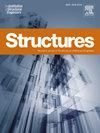钢筋混凝土的腐蚀性能和应变行为:天然火山灰在混凝土混合物中部分替代微二氧化硅的影响
IF 4.3
2区 工程技术
Q1 ENGINEERING, CIVIL
引用次数: 0
摘要
伊朗南部的钢筋混凝土结构容易受到氯离子腐蚀,因此需要采取措施降低混凝土渗透性并保护预埋钢筋。微二氧化硅通常以8 %的水泥重量加入,以提高耐久性。在最近的一项调查中,作者开发了一种创新的混凝土混合设计,用天然火山灰代替微二氧化硅,同时确保符合建筑行业规定的严格的耐久性和强度要求。目前的研究通过精确地检查钢筋在混凝土梁中的腐蚀性能,使用前面提出的八种配合比设计来推进上述调查。16根梁准备和经受60天的加速腐蚀,使用5 %氯化钠溶液和外加电流模拟恶劣环境。每10天记录一次横向应变,以评估与钢筋腐蚀有关的变形。随后,对梁进行解构以测量钢筋腐蚀速率。结果表明,含有4 %微二氧化硅和12.5 %火山灰的混合设计与含有8 %微二氧化硅(分别为8.9 %和8.1 %)的对照混合设计的腐蚀水平几乎相同。进一步分析表明,横向应变与腐蚀速率之间存在明显的关系,腐蚀越严重,应变越大。含有超过25% %火山灰含量的混合物经历了显著的双向横向应变,这是由于腐蚀产物在梁内积累了内部压力。本文章由计算机程序翻译,如有差异,请以英文原文为准。
Corrosion performance and strain behavior of reinforced concrete: Effect of natural pozzolan as partial substitute for microsilica in concrete mixtures
Reinforced-concrete structures in southern Iran are susceptible to chloride-ion-induced corrosion, thus necessitating measures to reduce concrete permeability and protect embedded steel reinforcements. Microsilica is conventionally added at a cement weight of 8 % to enhance durability. In a recent investigation, the authors developed an innovative concrete mix design that replaces microsilica with natural pozzolan while ensuring compliance with the stringent durability and strength requirements stipulated by the construction industry. The current study advances the abovementioned investigation by precisely examining the corrosion performance of steel reinforcements in concrete beams constructed using eight mix designs proposed earlier. Sixteen beams are prepared and subjected to 60 d of accelerated corrosion using 5 % sodium-chloride solution and an impressed current to mimic harsh environments. Transverse strains are recorded every 10 d to assess deformation related to reinforcement corrosion. Subsequently, the beams are deconstructed to measure the rebar corrosion rates. The results indicate that the mix design containing 4 % microsilica and 12.5 % pozzolan exhibit corrosion levels almost identical to those of the control mix with 8 % microsilica, i.e., 8.9 % and 8.1 %, respectively. Further analysis shows a clear relationship between the transverse strain and the corrosion rate, with higher corrosion resulting in greater strain. Mixes containing more than 25 % pozzolan content experience significant bidirectional transverse strains, which is attributable to the accumulation of internal pressure inside the beam due to corrosion products.
求助全文
通过发布文献求助,成功后即可免费获取论文全文。
去求助
来源期刊

Structures
Engineering-Architecture
CiteScore
5.70
自引率
17.10%
发文量
1187
期刊介绍:
Structures aims to publish internationally-leading research across the full breadth of structural engineering. Papers for Structures are particularly welcome in which high-quality research will benefit from wide readership of academics and practitioners such that not only high citation rates but also tangible industrial-related pathways to impact are achieved.
 求助内容:
求助内容: 应助结果提醒方式:
应助结果提醒方式:


